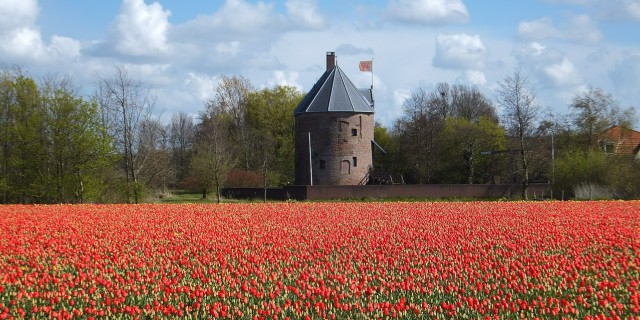Adam Sundberg, Ph.D. student in history, Class of 2015
Growing up in the same house with an evolutionary botanist and a historian clearly had an impression on Adam Sundberg. He and his parents spent many vacations at national parks and going camping. Now, as an environmental historian, he can see the role his upbringing played in his career.
“I think they cultivated my interests in a sort of indirect way,” Sundberg said.
Sundberg, a Ph.D. candidate, was drawn to environmental history as a field of study during an undergraduate study abroad trip in the Netherlands.
Initially deciding to study in the Netherlands because of his interest in art from the Dutch Golden Age, he found a whole new interest as his plane descended into Amsterdam. His first views of the Dutch landscape were transformative.
“Everyone has seen the pictures of just fields and fields of tulips, the striking colors, but it’s also very rectilinear and derivative of centuries of reclamation and division of landscape,” Sundberg said. “I’ve never been in a place that was more human altered than the Netherlands.”
That semester he really began thinking of environmental history as a career path, and the Netherlands has since become the focal point of his dissertation. He was fascinated by the people and the history, by the Netherlands being the ultimate realization of this impulse for people to manage their landscape.
When seeking out graduate programs, Sundberg says it was an easy decision.
“Coming to KU was an opportunity for me to work in one of the preeminent environmental history departments in the country,” Sundberg said. “KU is one of the top three. And the opportunity to work here? I couldn’t ignore it.”
Immediately after receiving his master’s from KU, Sundberg received a Fulbright Scholarship in which he studied the Netherlands in the 18th century, a period of economic and environmental decline that soon became the subject of his dissertation.
“My dissertation is an explanation of what was decline, why did it happen and how did it manifest. Primarily, how did it manifest in the guise of natural disaster?” Sundberg said.
He’s interested in the fact that these same cultural and environmental vulnerabilities return again and again, but people seem to forget disasters of the past.

“Flooding will happen one year, and there’s immediate reaction to it. But at what point does that cultural learning about disaster end?” Sundberg asked.
Sundberg is currently in his second year of funding for an NSF Doctoral Dissertation Research Improvement Grant. This grant has been integral in expanding the geo-spatial components of his research.
The first year of his funding focused on mapping the movements of an invasive mollusk, and this year he’s building on prior research by mapping mortality records from a cattle plague in the 1740s.
Technically he is finished with his dissertation, but Sundberg added with a bit of a laugh, “These things are never really complete. It could stand improvement.” Improvements that he hopes will lead to a book manuscript.
Creighton University is Sundberg’s next step. He has accepted a tenure-track assistant professorship in history and digital humanities. His distinctive, interdisciplinary skillset played a large role in receiving this position as a digital humanist.
He credits KU’s strength of interdisciplinary research and education for much of his success. He’s had the opportunity to collaborate with anthropologists, biologists, and even English professors.
“Interdisciplinarity is fundamental to what I do, and I can’t imagine an environment that could have fostered that more effectively, readily and in a more fun and engaging way than KU,” Sundberg said.
